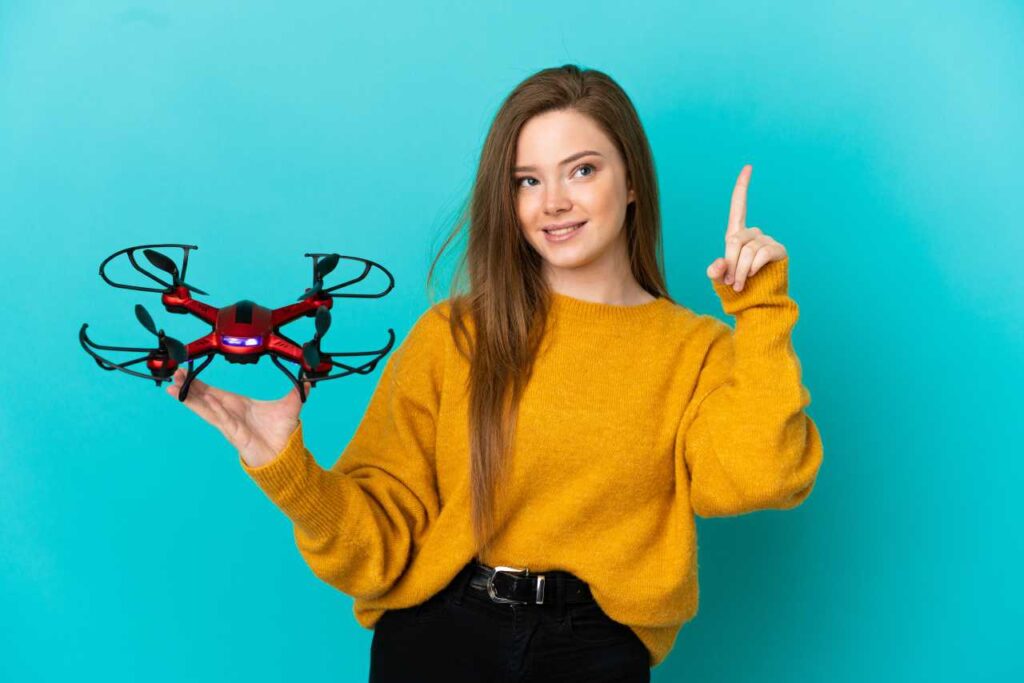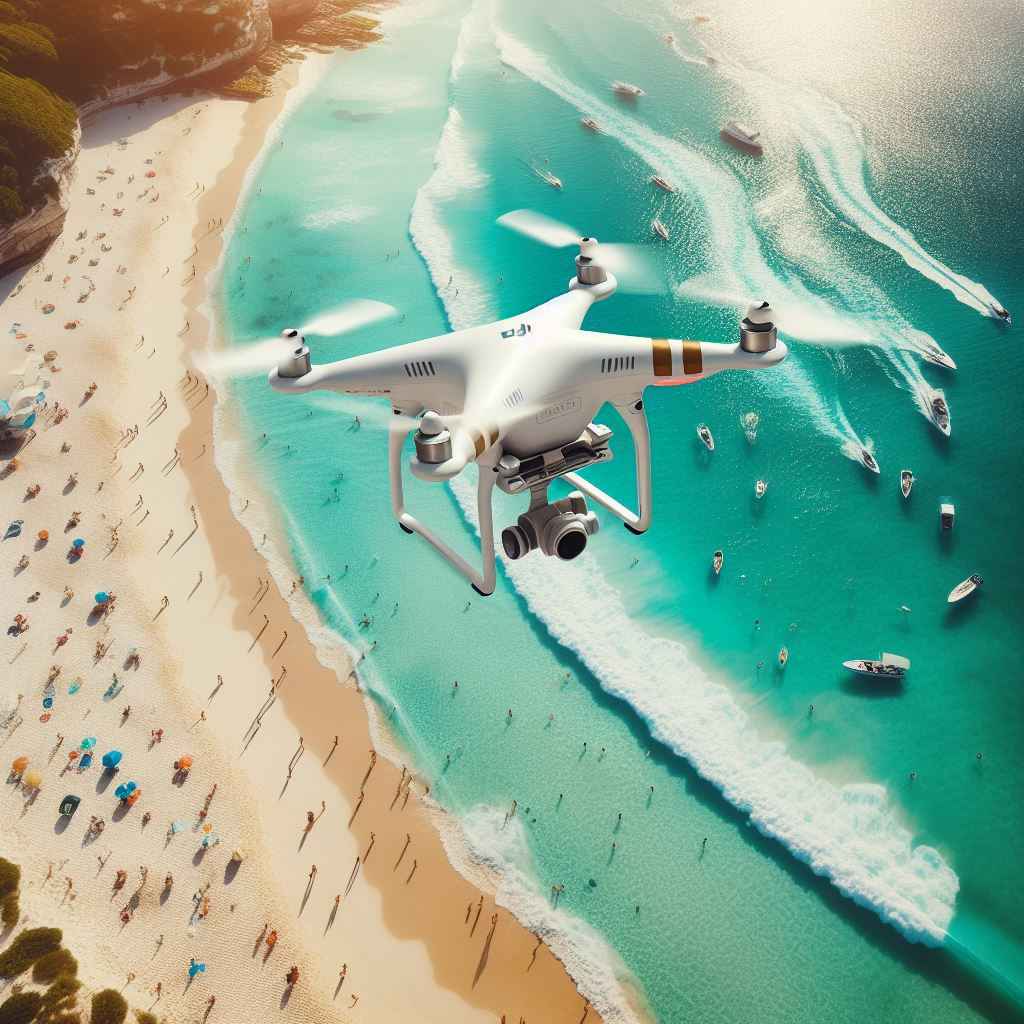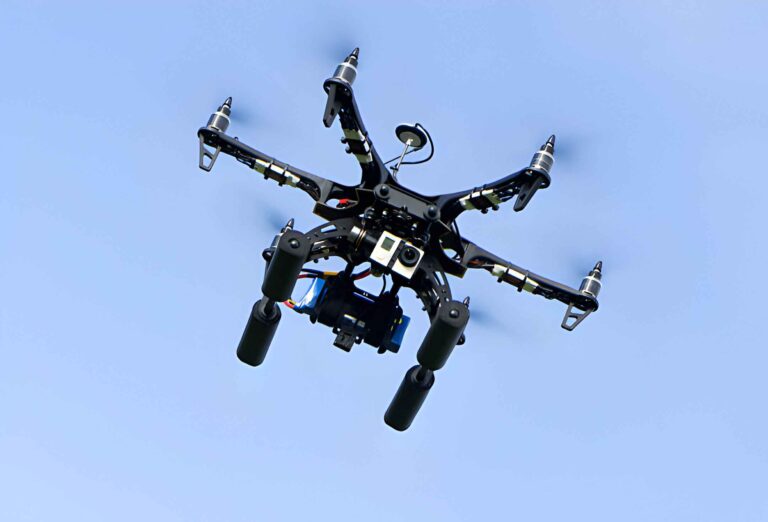In today’s world, finding a good drone at a low price is tough. This is especially true for beginners. The best drone under $500 offers a mix of quality and affordability. This price range suits new drone users well.
Budget-friendly drones are now more popular. They have features once only in expensive models. These drones meet the needs of many users:
- Hobbyists
- New photographers
- Drone video fans
- Flight enthusiasts
Whether you’re taking aerial photos or just flying for fun, there’s a drone for you in this price bracket. While we’ve looked hard to find the best drone under 500, we also recognize the demand for even more affordable options. That’s why we’ve included choices for the best drone under 200. These picks are easy on the wallet and come with features great for beginners and advanced flyers. Stay tuned for more details on each model. We’ll help you pick the perfect budget drone.
DJI Mini 2 SE – Our Best Drone Under 500
The DJI Mini 2 SE is a standout in the affordable drone market. It’s the most budget-friendly in the DJI Mini range. This camera drone is small, easy to handle, and perfect for everyone. Both beginners and veterans will find it useful. This is definitely the best drone under 500.
It weighs less than 250g, which is great for easy flying. The camera is impressive too. It records in 2.7K resolution at 30 fps and takes 12-megapixel photos. The price is a bit higher than the first Mavic Mini. But, it offers better features like a newer camera, stronger motors, and better remote connection.
This drone is also travel-friendly. It’s small and doesn’t need registration in many places. The starting price is $339. A special Fly More Combo is available for $489. This includes extra batteries and other tools. The DJI Mini 2 SE does well against more expensive models. It’s less costly but still performs strongly.
Expect about 30 minutes of flight time. Real use might give you 26 or 27 minutes. Charging is easy with USB-C. The DJI Mini 2 SE is a top choice for those wanting quality at a low cost.
Holy Stone HS720G
The Holy Stone HS720G is an excellent choice for both beginners and those advancing to professional drones. It’s a compact and foldable drone, easy to take anywhere. The price is affordable, offering high-end features, our second choice for the best drone under 500.
This drone’s camera captures in 2K and 4K. The 2-axis gimbal and vibration-damping add stability. It’s good for clear photos and steady videos. GPS and optical flow sensors enhance flight. They aid in automatic landing, altitude holding, and orbit flight. The return-to-home feature is a big plus.
It handles wind well and needs FAA registration due to its weight. The flight time is about 26 minutes. You can extend this with extra batteries. It lacks obstacle avoidance and a 4-axis gimbal. But, it’s a top pick for practice before stepping up to more advanced models.
Potensic Dreamer 4K Pro
The Potensic Dreamer 4K Pro is a top-tier drone, ideal for both enthusiasts and professionals. It boasts a 3-axis gimbal camera. This ensures stable, clear aerial footage. The drone’s FPV GPS system enhances its navigation capabilities. Moreover, it impresses with a 2KM transmission range.
A major highlight is its 28-minute flight time, supported by a robust brushless motor. This combination delivers both power and endurance. The auto-return feature increases safety and ease of use.
Though missing a metal carry case and 32G SD card, the Dreamer 4K Pro’s performance and user-friendliness offer excellent value. Its compact design packs in numerous features, making it a wise choice for those seeking premium quality without a high cost.
DJI Mini 2
The DJI Mini 2 remains a compelling choice in the drone market, even against newer models like the DJI Mini 3. Its appeal lies in its lightweight design, making it an ideal drone for beginners. Many experts rate it as the top beginner-friendly drone.
This model excels in capturing high-resolution footage, rivaling newer drones. It boasts a speed of over 29 mph and provides a substantial 31 minutes of flight time. The drone comes with three versatile flight modes. These improve the flying experience for different users.
The OcuSync 2.0 technology in the Mini 2 outperforms the Mini SE. It excels in signal range and quality. It lacks obstacle avoidance and advanced intelligent flight modes. Yet, its basic functions and built-in safety features are strong.
Moreover, the DJI Mini 2 has gained more attention for its affordability. With the release of newer models, it offers great value for those looking for quality without a high cost. Its mix of cost, performance, and ease of use makes the Mini 2 popular. Budget-minded drone fans find it especially appealing.
Ruko F11GIM2
The Ruko F11GIM2 is a standout in the budget drone market. It offers a seamless flying experience, bolstered by GPS functionality and 5G smooth transmission. This drone is a hit for those who need quality without a high cost.
It boasts a 4K camera with 2-axis gimbal stabilization. This setup ensures smooth videos and sharp images. The electronic image stabilization adds to its appeal. It flies up to 3 kilometers and lasts about 28 minutes on a single charge. Note, actual flight time can vary.
A notable feature is its level 3 wind resistance. This helps it stay stable in breezy conditions. While it lacks obstacle avoidance and has limited camera stabilization, it’s still great for beginners. Its user-friendly features and affordability make it an excellent choice.
The Ruko F11GIM2 is often regarded as one of the best camera drones in its price range. It suits both novice and professional flyers, offering a balance of features and ease of use.
What to Consider When Buying a Drone Under $500 2024

Flight Time
When choosing a drone under $500, flight time is key. It determines how long you can enjoy flying. Look for drones with longer battery life. Drones offering longer minutes of flight time let you explore more. Consider drones with options for extra batteries to extend your flying sessions.
Control Range
Control range is about how far the drone can go. Understanding how drone controllers work plays a crucial role in this aspect. A larger drone’s range means you can explore distant areas. It’s essential for both fun and aerial photography. Knowing the mechanics behind the controllers helps in maximizing the potential of this range.
Camera Quality
The camera quality of a drone affects your aerial photos and videos. High-quality images, UHD resolution, and stable gimbal systems are crucial. Good image quality and options for RAW photos or cinematic footage make a big difference.
Speed
Speed is important for both fun and function. When discussing drone capabilities, a common question arises: how fast can a drone fly? High speeds allow for exciting flying and better first person view (FPV) experiences. It also affects the video feed quality during fast movements.
Size and Weight
The size and weight of a drone influence its portability. A compact drone or foldable drone is easier to carry. Heavier, larger drones might offer more features but can be less portable.
Smart Features
Look for smart features like obstacle avoidance and intelligent flight modes. These features can greatly enhance the flying experience, especially for beginners. Among these features, it’s important to understand what is headless mode on a drone. This mode can simplify navigation and control, making it easier for new pilots to maneuver the drone without worrying about its orientation.
Durability and Repairability
Finally, consider the durability and repairability of the drone. Understanding how drones work is essential in this regard. Drones that are easy to repair with available parts, like propellers, offer better long-term use and cost-effectiveness. A solid grasp of the mechanics behind drones not only aids in their maintenance but also ensures more informed purchasing decisions.
Frequently Asked Questions (FAQ)
Do you need a drone license to fly as a hobby?
In the United States, hobby drone pilots must take and pass the FAA’s TRUST test and register their drone. This is a crucial step in understanding how to fly drones legally. A Remote Pilot Certificate is also required under the FAA’s Small UAS Rule (Part 107).
Can I fly my drone higher than 400 feet?
Flying a drone higher than 400 feet is generally illegal in the United States, as it poses a hazard to manned aircraft. However, commercial drone pilots licensed under Part 107 can fly above 400 feet if they are within 400 feet of a structure.
Do small drones show up on radar?
Yes, small drones can be detected by radar systems designed for it. Radars can detect and track any object that reflects their signals, including small drones. However, the effectiveness of radar depends on various factors like the size, speed, altitude of the drone, and the type of radar.
What are the new rules for drones in 2023?
In 2023, U.S. drone pilots must follow these rules. Fly at or below 400 feet. Register drones over 0.55 lbs. Use the B4UFLY App for airspace info. Recreational pilots also need to pass the TRUST exam. They should follow FAA safety guidelines. Plus, get authorization for flying in controlled airspace.
Can I shoot down a drone that is spying on my property?
Shooting a drone over your property is against the law. It’s a federal offense to shoot down any aircraft. Using a weapon in this way can be viewed as criminal mischief.
Can a drone be traced back to you?
You can track drones back to their owners. This works best for drones that are registered and have a unique ID. Systems like GPS and RFID are used to monitor them.
How high can the DJI Mini 2 fly?
The DJI Mini 2 reaches up to 500 meters high. Its takeoff altitude can hit 4000 meters. This varies with local rules. In the U.S., the legal flight ceiling is about 120 meters, or close to 400 feet.
What airspace can drones fly in?
In the U.S., drones are permitted for both fun and work, under FAA rules. Hobby drones need to be in sight at all times, follow safety rules, and usually fly in Class G airspace. To fly in controlled spaces like Class B to E, you need permission.
Does the FAA know when I fly my drone?
New FAA rules from September 2023 mean US airspace drones will be tracked. Pilots must meet Remote ID rules. Drones without Remote ID can only fly in FAA-Recognized Identification Areas (FRIA).
Can I make my property a no-fly zone?
Creating a no-fly zone over your property is limited. While you can register on NoFlyZone.org to set up a geo-fence, major drone manufacturers like DJI and Parrot may not recognize it. Currently, only seven smaller drone makers honor these requests. The FAA may introduce new regulations that could change this situation.
Who is responsible for making sure a drone does not fly too high?
The responsibility to ensure a drone doesn’t fly too high falls on the drone operator. They must adhere to altitude limits set by aviation authorities, typically around 400 feet above ground level.
What is the average cost of a drone?
In 2024, consumer (beginner) drones range from $30 to $150. Camera drones cost between $400 and $1000. Racing drones range from $150 to $500, while professional drones start at $3,000. Commercial drones begin at $10,000.
What is a Class 1 drone?
A Class 1 drone typically refers to drones weighing less than 250 grams. These are often considered ‘sub 250 legacy drones’ if manufactured before January 1, 2023, and are usually hobbyist drones built without specific manufacturing regulations.


